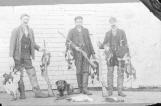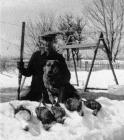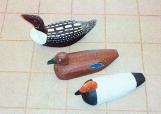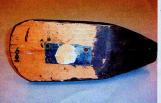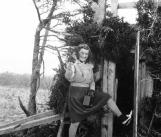1
Nature has provided wildlife for man to hunt. From the time of settlement of Long and Brier Islands, this wildlife has been used to provide food. Although in modern time hunting may be considered more sport than necessity, for a long time it provided food when none other may have been available.There were few Island homes without a dog bred to retrieve ducks shot over the water ( usually a Labrador Retriever), or a beagle to aid in rabbit hunting . If you personally didn't own a dog, there was usually a friendly neighbour who would either loan you his, or permit you to accompany him on the hunting trip. From an early age most Island men were trained to use a shotgun or rifle. Duck hunting at the seashore as the sun rose or rabbit hunting on a winter afternoon both were a large part of the fabric of life, as witnessed by this item in the social column in a local newspaper:Westport:" Last week was very rough and cold and the sporting folks enjoyed themselves shooting wild duck and woodcock. Mr. S.T. Payson and A. Suthern bagged 7 woodcock Friday morning and they had plenty of
wild duck to give their friend."
On Long and Brier Islands, in season, men were able to hunt deer. They were quite numerous early on and each hunter was allowed two. Deer camps were constructed in the woods from brush and wood so as to allow the hunter to have an area from which to study the deer's habits. As illegal hunting dwindled the herd, the catch was cut back to one deer per hunter, and it must be a buck.
Trappers were able to capture mink and muskrat and sell the furs for needed cash.
Many birds such as woodcock, partridge, pheasants and ducks provided tasty eating , and gave the cooks of the house a chance to try new baking/stewing/roasting techniques. Wild ducks sometime became Christmas dinner. Rabbits, snared or shot, often made a good supper , whether it was fricasseed or in rabbit stew.
7
Samples of taxidermy done by Clair Whitenect from species captured on Long Island.1930
Freeport, Nova Scotia, Canada

8
Lillie Small at the front of a hunting camp built on the Small family farm .1930
Central Grove, Nova Scotia, Canada
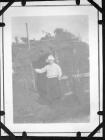
10
Russell Whitenect and Burpee Campbell display a buck captured on an Island hunting expedition.1938
Freeport, Nova Scotia, Canada

11
Clifton Outhouse with a rabbit hound and a number of rabbits shot during a winter's hunting trip.1930
Tiverton, Nova Scotia, Canada

12
Clifton Outhouse poses with his dog and the rabbits caught that day.1930
Tiverton, Nova Scotia, Canada
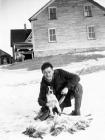
13
Clifton recalls how, in the 1930s, there were numerous fox ranches in Tiverton and theneighbouring villages. He would go rabbit hunting and then sell the them to the ranchers as fox food.
